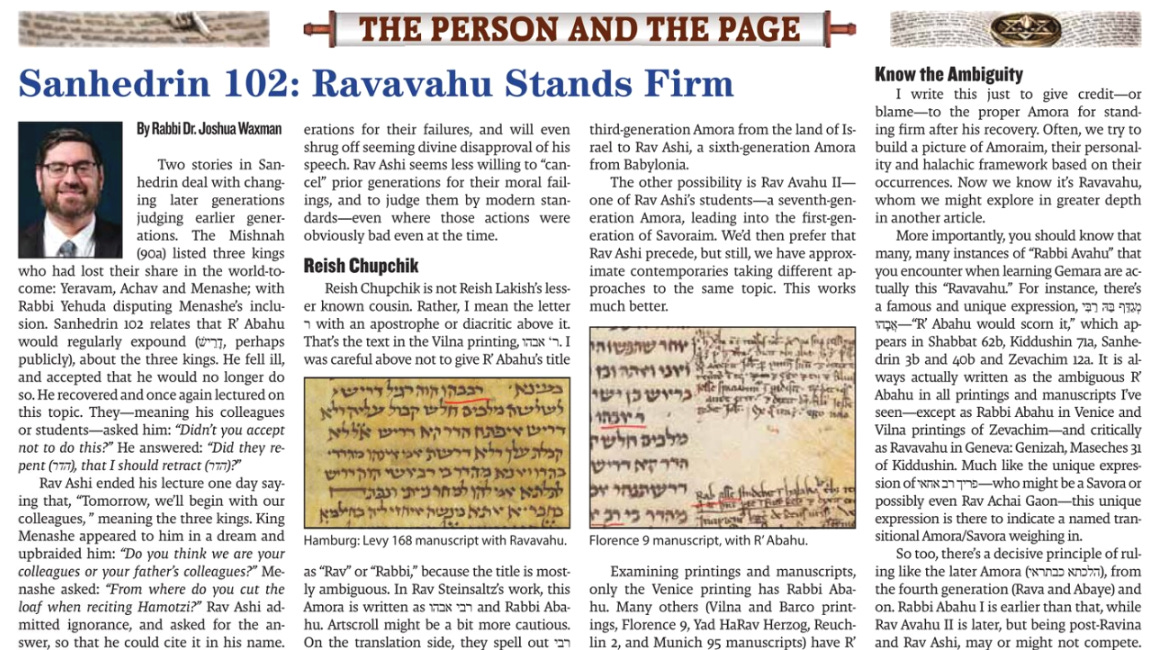Two thoughts on today’s daf.
First, on Avodah Zara 35b, we have Rav Malkiya say something in Rav Adda bar Ahavah I’s name.
רַב מַלְכִּיָּא מִשְּׁמֵיהּ דְּרַב אַדָּא בַּר אַהֲבָה אָמַר: מִפְּנֵי שֶׁמַּחְלִיקִין פָּנֶיהָ בְּשׁוּמַּן חֲזִיר. רַב חִסְדָּא אָמַר: מִפְּנֵי שֶׁמַּעֲמִידִין אוֹתָהּ בְּחוֹמֶץ. רַב נַחְמָן בַּר יִצְחָק אָמַר: מִפְּנֵי שֶׁמַּעֲמִידִין אוֹתָהּ בִּשְׂרַף הָעׇרְלָה.
The Gemara suggests additional reasons for the decree of the Sages. Rav Malkiyya says in the name of Rav Adda bar Ahava: The cheese is prohibited because gentiles smooth its surface with pig fat. Rav Ḥisda says: It is because they curdle it with vinegar produced from their wine, from which it is prohibited to derive benefit. Rav Naḥman bar Yitzḥak says: It is because they curdle it with sap that is subject to the prohibition against consuming the fruit of a tree during the first three years after its planting [orla].
All the times this pattern occurs, there is a discussion of whether given quotes are from Rav Malkiyah or Rav Malkiyo. I wrote an article about this.
This is the exception, and the discussion is not made of which of the six examples is which. As I think I wrote elsewhere, this is because they already recently had this discussion in this tractate, on Avodah Zarah 29b, regarding haircuts. There’s no need to be repetitive.
Second, on Avodah Zarah 35a, they discuss reasons gentile cheese was forbidden. There’s a trend in which an explanation is offered and someone else dismisses it.
One of these is Rabbi Yehoshua ben Levi, a first-generation Amora, that it was a concern due to puncturing by the fangs of a snake. Rabbi Yirmeyah scoffed at this idea:
מְגַדֵּף בַּהּ רַבִּי יִרְמְיָה: אֶלָּא מֵעַתָּה, יְבֵשָׁה תִּשְׁתְּרֵי, יָשָׁן תִּשְׁתְּרֵי! דְּאָמַר רַבִּי חֲנִינָא: יָבֵשׁ מוּתָּר, אֵין מַנִּיחוֹ לְיַבֵּשׁ, יָשָׁן מוּתָּר, אֵין מַנִּיחוֹ לְיַשֵּׁן.
Rabbi Yirmeya would ridicule [megaddef ] Rabbi Yehoshua ben Levi’s explanation that the prohibition was due to the concern for puncturing: If that is so, dry cheese should be permitted, and likewise aged cheese should be permitted, as Rabbi Ḥanina says: With regard to exposure, a dry substance is permitted even if it was originally in the form of an uncovered liquid, because a snake’s venom does not let it dry, i.e., congeal. And an aged liquid is permitted, as a snake’s venom does not let it age, as it causes it to spoil instead.
So he ridiculed based on Rabbi Chanina. This is followed by an answer by Rabbi Chanina, which is strange, since Rabbi Chanina was a basis, not a speaker.
אָמַר רַבִּי חֲנִינָא: לְפִי שֶׁאִי אֶפְשָׁר לָהּ בְּלֹא צִחְצוּחֵי חָלָב, וּשְׁמוּאֵל אָמַר: מִפְּנֵי שֶׁמַּעֲמִידִין אוֹתָהּ בְּעוֹר קֵיבַת נְבֵילָה.
The Gemara presents two alternative reasons for this decree of the Sages. Rabbi Ḥanina says: The cheese is prohibited because it is not possible for it to have been made without containing particles of non-kosher milk. And Shmuel says: The cheese is prohibited because it is curdled with the skin of the stomach of an unslaughtered animal carcass.
But see Masoret HaShas, square brackets [so by Rabbi Yishayahu Pick], who emends to Rabbi Yirmeyah, based on Tosafot.
This makes more consistent sense. And indeed, I can point to girsaot supporting it.
However, before that, what troubled me is that מְגַדֵּף בַּהּ is a famous unique expression, usually associated with Rabbi Abahu, or as I would rather put it, Ravavahu.
Ravavahu Stands Firm (article summary)
My article last week was about Ravavahu. You can read it online in the image below, or else at the following links: paid Substack, Jewish Link HTML, flipbooks. An outline below the image.
The former is a third generation Amora, while the latter, Ravavhu, is a much later Amora, a student of Rav Ashi, so a quasi-Savora. I think it is the latter with the catchphrase.
Now let us look at textual variants. The three printings plus Munich 95 do have R’ Yirmeyah:
Note that Munich 95 also has a second Rabbi Yirmeyah, which echoes Mesoret HaShas. So far, it is either a duplication of Rabbi Chanina or of Rabbi Yirmeyah.
Two other manuscripts, JTS 15 and Paris 1337 have what I anticipated:
That is, it is R’ Abahu who is megadef. Further, JTS 15 even notes that there are some nuschaot which don’t follow that R’ Abahu with a comment from Rabbi Yirmeya. I suppose therefore it is plainly stated by the Stamma.
Here is JTS 15:
I could imagine a messy manuscript allowing transition from R’ Abahu to R’ Yirmeyah. Where the ר is the same, the heh is present, and parts of the formed aleph and bet can look similar to a resh mem. Not within JTS, but for the sake of comparison, this is what R’ Yirmeyah looks like:
See how the yud resh looks kind of like the aleph?
Here is the marginal note that suggests that some texts lack the instance of Rabbi Yirmeyah (which for us would be the second instance).
I sense a kind of tug of war here, where there’s a reason to assume R’ Avahu — that is the common megadef and a reason to assume R’ Yirmeyah — a duplication of a name from later, especially where it is an ela amar X as above; that we have an objection and then a new proposed idea. Often, but not always, it is the same person making the objection and giving the new idea — though I’ve argued that this is backfilled, with the Stamma supplying the objection in order to justify the new idea.
Anyway, I think it is indeed Ravavahu here.











